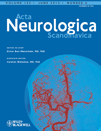Correlation between crossed cerebellar diaschisis and clinical neurological scales
Abstract
Szilágyi G, Vas Á, Kerényi L, Nagy Z, Csiba L, Gulyás B. Correlation between crossed cerebellar diaschisis and clinical neurological scales. Acta Neurol Scand: 2012: 125: 373–381. © 2011 John Wiley & Sons A/S.
Background – A common consequence of unilateral stroke is crossed cerebellar diaschisis (CCD), a decrease in regional blood flow (CBF) and metabolism (CMRglu) in the cerebellar hemisphere contralateral to the affected cerebral hemisphere. Former studies indicated a post-stroke time-dependent relationship between the degree of CCD and the clinical status of acute and sub-acute stroke patients, but no study has been performed in post-stroke patients.
Objectives – The objective of this investigation was to evaluate the quantitative correlation between the degree of CCD and the values of clinical stroke scales in post-stroke patients.
Materials and Methods – We measured with positron emission tomography (PET) regional CBF and CMRglu values in the affected cortical regions and the contralateral cerebellum in ten ischaemic post-stroke patients. Based on these quantitative parameters, the degree of diaschisis (DoD) was calculated, and the DoD values were correlated with three clinical stroke scales [Barthel Index, Orgogozo Scale and Scandinavian Neurological Scale (SNS)].
Results – There were significant linear correlations between all clinical stroke scales and the CCD values (Barthel Index and Orgogozo Scale: P < 0.001, for both CBF and CMRglu; SNS: P = 0.007 and P = 0.044; CBF and CMRglu, respectively).
Conclusions – The findings indicate that DoD can be used as a quantitative indicator of the functional impairments following stroke, i.e. it can serve as a potential surrogate of the severity of the damage.




